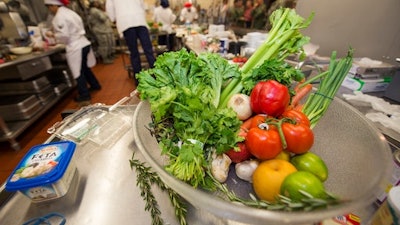
In 1954, Swanson revolutionized the food industry by introducing frozen dinner kits. Initially, Swanson produced 5,000 TV dinners, expecting modest growth. Within a year, they had sold over 13 million TV dinners.
People were hungry for convenience, and the market listened by expanding their logistical operations with refrigeration technology. By 1959, U.S. consumers spent over $2.7 billion annually on frozen foods. None of this would have been possible without a logistical shift in more reefer and refrigerated truck technology.
Today, times have changed again. With more health-conscience consumers, a global pandemic affecting every industry and higher obesity and heart disease levels, fresh fruits and vegetables are making a comeback. Many consumers opt for organic, locally grown produce, and supply chain companies must adapt to an already precarious process. With the advent of meal delivery services, fresh produce has become “in” again.
Thankfully, modern supply chains are more efficient when it comes to food shipments than in past years. However, just because this process has improved over the years, it is still quite possible for mistakes to occur that can negatively impact the quality and integrity of our global food supply.
Here are three main challenges shippers face when transporting produce:
1. Produce shelf life
When a company ships produce across the country or internationally, they are racing against a strict shelf-life clock. The shelf life of produce determines how long fruits or vegetables stay fresh, which varies from product to product. Shelf life not only affects taste, but also affects its appearance. Ugly vegetables fall to the bottom of the pile. For this reason, shippers must work closely with truckers to ensure punctual deliveries along the way. Clear communication between the shipper and trucker can be the difference between a truckload of fresh produce or a million-dollar mistake.
2. Truck temperatures
In the cold chain logistics world, not all cold temperature is created equal. With perishable foods, exact temperatures matter. Different produce requires a specific temperature range. Even a change of 1-2 degrees can potentially spoil the produce. Reefer containers are ideal for moving produce because their temperatures can be manually adjusted to stay within a target range during transportation. Reefer containers also have multiple temperature zones to transport various produce types simultaneously. Shippers should take care to include the temperature on the Bill of Lading so the destination can coordinate with their trucker to have a dedicated trailer ready.
Another factor to consider is the outside temperature. If routes pass through states or countries with extreme weather, this may impact the reefer trailer’s temperature. Sometimes, a truck may need to drive through winter weather and adjust the trailer temperature, so the range is warm enough. These instances have to be taken into account when traveling cross country or overseas.
3. FMSA regulations
In 2011, President Obama signed the Food Modernization and Safety Act to regulate and set safety standards in handling all foodstuff. The act took a stance to proactively prevent foodborne illness and diseases by laying down the following sanitary standards for transporting and handling produce:
● Clean vehicles. All vehicles handling produce must be thoroughly washed and sanitized before and after deliveries to prevent contamination of any kind.
● Controlled temperature. Drivers must acknowledge temperature requirements for their shipment and report the temperature before, during and after delivery. They must manually adjust the temperature as needed to make sure the produce does not spoil and must report any irregularities or temperature shifts.
● Compliance documents. Specific documents must be provided to drivers before delivery and kept for recordkeeping purposes. These documents cover vehicle cleanliness, the trailer’s temperature, sanitation records and procedure records.
● Seasonality. Unless you live in California, where most fruits and vegetables grow yar-round, you have to consider what season yields which fruits and vegetables.
● Origin. Produce origin is also a critical factor regarding shelf life. Tighter shelf lives mean suppliers should be as close to the final destination as possible. If you have the option of sourcing strawberries from a local farm 4 hours away from the final destination versus a full day’s trip, chances are you’d source your strawberries from the farm instead.
Click here to hear more about food safety:
With more consumers demanding fresh fruits and vegetables as part of their daily diet, produce logistics is at an all-time high. Here’s how you can enact procedures to reduce the potential of spoilage:
Pre-plan shipments and track rigorously
Creating a detailed shipping strategy is key to successfully transporting your produce. With ever-present volatility in the market, especially when it comes to produce, prioritizing shipments in advance will help you navigate the ups and downs of the regional demands. Communicate with your carriers ahead of time if you know load readiness will change; they will appreciate the open dialogue and will likely be more flexible to accommodate your needs.
Along with planning, tracking your freight is another fundamental factor to your success. Confirm tracking requirements with your carriers to ensure you have the visibility you need to stay up to date on the status of your products. Not only will this help adjust pick-up and delivery procedures if delays occur, but it will also help reduce the potential of damages as well.
Take care of packaging
Most freight damage within the food supply chain occurs on the road during the actual transport of the goods.
Some of the most common sources of food freight damage include broken pallets being used, heavy freight stacked on top of light cargo, or products that are not correctly secured to the pallet.
As such, to avoid the potential of damaged food products, follow these basic packing best practices:
● Never use a damaged pallet. It’s essential to inspect each pallet before stacking products on them. Make sure all bottom and top boards are secured and not broken. When in doubt, recycle the broken pallet and use one that shows little to no signs of wear and tear.
● Cross stack boxes. Cross stack boxes to distribute weight equally on the pallet. To do this, rotate each new layer of boxes to run lengthwise in opposite directions with the heaviest boxes on the bottom-most layers.
● Use high-quality shrink-wrap. Once all packages are stacked on good pallets, the final step is to wrap them in a high-quality shrink wrap. While it might be tempting to use cheaper materials, this could end up costing you even more money in the end. That’s the high cost of cutting corners.
Work with proven carriers
Some carriers are better than others when it comes to shipping food throughout the supply chain. Whether it’s their on-time delivery record, reduced damage freight claims or compliance with all shipping regulations, it’s always best to work with carriers who are at the top of their food supply chain game. Experts in shipping, such as a third-party logistics company, can help you procure the most qualified carriers to ensure your products gets to the end consumer on time and intact.




















